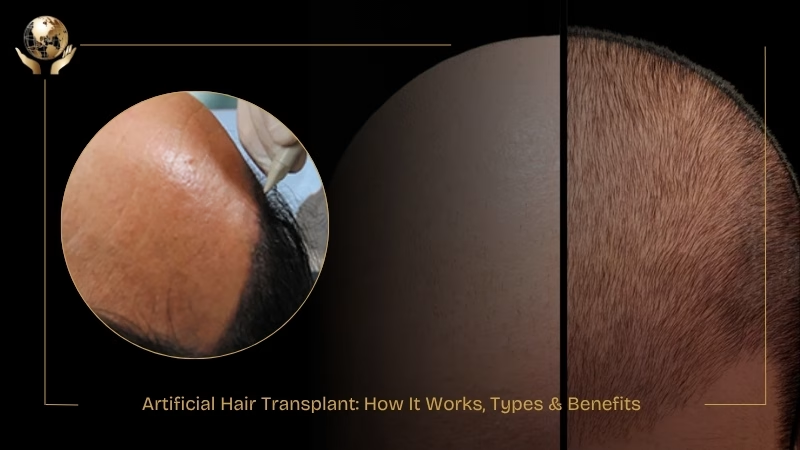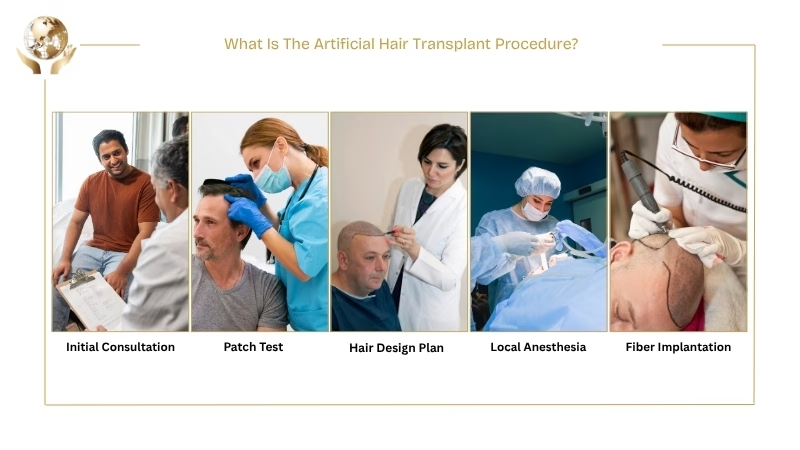Artificial Hair Transplant: How It Works, Types & Benefits
There are certain cases when people lose their hair to such an extent that a traditional transplant is impossible. An artificial hair transplant offers an alternative where natural grafts cannot be located or used. This technique is often selected by patients who want immediate volume, shape, and density.
An artificial hair transplant uses biocompatible synthetic fibers to replicate natural hair. These fibers are implanted into the scalp to provide instant coverage. The procedure is minimally invasive and offers visible improvement in a short period.
This guide explains the process, fiber materials, safety aspects, benefits for men and women, and more. It also mentions how artificial hair transplant contrasts with traditional transplants and provides tips for better healing.

What Is an Artificial Hair Transplant?
An artificial hair transplant involves inserting synthetic strands into the scalp to create the look of real hair. These synthetic strands are made from biocompatible materials, such as polyamide or polyester. The process does not need any donor area. This is why it is used for people with complete baldness or scalp scarring.
Key Characteristics
- Fibers do not grow but maintain shape and length.
- Each fiber is placed one by one.
- Mimics the color, thickness, and texture of natural hair.
- Does not disturb remaining hair or scalp health.
Who Can Benefit
- People with alopecia totalis
- Patients with scalp scars or burns
- Those with no usable donor hair
- People who want fast results without shaving
This method is helpful for individuals with permanent hair loss. It provides quick cosmetic improvement when other options are not possible.

Artificial vs Traditional Hair Transplant
Both artificial and traditional options improve hair appearance, but they differ in method, healing time, and how long the result lasts. This chart compares the main points:
| Feature | Artificial Hair Transplant | Traditional Hair Transplant |
|---|---|---|
| Graft Source | Synthetic fibers | Patient’s natural hair |
| Healing Time | Short (3-7 days) | Long (10-14 days) |
| Rejection Risk | Yes (small chance) | None |
| Results Duration | Temporary (6-12 months) | Permanent |
| Baldness Suitability | Yes | Limited |
| Procedure Time | 1-2 hours | 4-8 hours |
| Maintenance | Requires re-implantation | Low maintenance |
This table helps patients make an informed choice based on coverage needs, maintenance, and health.
Who Is Eligible For Artificial Hair Transplant?
Some people cannot have a natural hair transplant because of a lack of donor hair. An artificial hair transplant is best for individuals with extensive hair loss or damage to hair roots, including those with health issues, scarring, or failed past procedures.
Best Candidates
- Complete baldness
- Scarring alopecia or burn damage
- Chemotherapy hair loss
- Poor donor areas
Gender Differences
A patch test is important to ensure the scalp will accept the fibers without reactions. Most clinics in Turkey and other countries provide this as part of the evaluation.
Types of Synthetic Hair Transplants & Fiber Materials
Synthetic hair fibers vary in durability, appearance and acceptability by the scalp. Common types include Biofibre®, Nido, and Cyberhair®. Each has its own qualities based on strength and texture.

Common Fiber Materials
- Polyamide Fibers: Lightweight and strong.
- Polyester Strands: Smooth and allow natural movement.
- Keratin-Based Tips: Help secure the fibers in place.
Fiber Features
- Do not shed or degrade easily.
- Can handle sunlight and shampoo.
- Come in different lengths and colors.
- Available in straight, curly, or wavy forms.
| Material | Properties | Use Case |
|---|---|---|
| Polyamide Fibers | Lightweight, durable | Ideal for short to medium styles |
| Polyester Strands | Flexible, natural movement | Used in high-density implants |
| Keratin-Based Tips | Improved anchoring | Often for fake hair transplant users |
Most fibers come pre-sterilized and are approved for single-use only. They are not natural hair and thus require periodic care (every few months).
What Is The Artificial Hair Transplant Procedure?
The procedure of artificial hair transplant is easy and does not require general anesthesia. It is performed at a clinic and takes approximately one to two hours. The number of fibers placed depends on the degree of hair loss.

- Initial Consultation: Doctor checks scalp and medical history and explains expected outcomes.
- Patch Test: Small number of fibers are implanted. Wait two to four weeks to check for reactions.
- Hair Design Plan: Hairline, volume, and area of coverage are planned.
- Local Anesthesia: Numbing cream or injection is applied.
- Fiber Implantation: Fibers are placed manually with a device. A knot holds each fiber inside the scalp.
- Aftercare Instructions: Includes medicines, sprays, and cleaning tips.
Each session places 500 to 1500 fibers and follow-up visits may be planned to build more density.

Artificial Hair Transplant: Recovery, Aftercare & Longevity
The healing is normally rapid. Most individuals return to work after two to three days. However, the initial week of care is critical to prevent issues.
Immediate Recovery (0–7 Days):
- Redness, swelling, or itching
- No washing of scalp for five days
- Use antiseptic sprays prescribed by the doctor
- Avoid scratching the area
Long-Term Aftercare
- Use sulfate free shampoos
- Avoid sun exposure for two weeks
- Do not brush or pull the fibers hard
- Visit the clinic every three to six months
How Long Does It Last?
- Fibers stay in place for six to twelve months
- Some may fall out and need replacement
- Touch-ups are done to preserve the appearance
Such issues are handled during the regular check-ups, to detect rejection or infection. The effects may be long-term with proper care.
Artificial Hair Transplant: Risks & Safety Considerations
An artificial hair transplant is safe when performed by trained surgeons. But like any procedure, it has some risks and a patch test lowers the chance of side effects.
- Redness and itching
- Infection at the implant area
- Rejection of fibers by the immune system
- Pus or scalp inflammation

Rare But Possible
- Scarring
- Fiber loss due to inflammation
- Breaking of fibers from tension
| Risk | Chance | Prevention |
|---|---|---|
| Infection | Moderate | Antibiotics, antiseptics |
| Rejection | Low | Patch test before procedure |
| Redness Or Itching | Common | Calming lotions |
| Permanent Scarring | Rare | Skilled technique + hygiene |
Following the doctor’s instructions closely helps avoid most problems. Clinics must use approved fiber types and maintain strict hygiene during implantation. Safety also depends on proper patient selection and regular check-ups after the treatment.
Artificial Hair Transplant Cost Considerations
The artificial hair transplant cost depends on many things. This option is often cheaper than repeated natural graft sessions, but price varies.
What Affects the Cost?
- Country and City: Some locations charge less.
- Number of Fibers: More coverage means more cost.
- Fiber Brand: Products like Biofibre® cost more.
- Session Count: Some people need more than one session.
- Extra Services: Patch tests, PRP, and kits add to the price.
Clinics that offer artificial hair transplant services may have lower prices due to medical tourism programs. Always make sure the clinic is safe and licensed.

Artificial Hair Transplant Turkey: Why It’s Popular
People often choose artificial hair transplant clinics in Turkey because of the balance between cost and quality. Turkey is a major hub for medical travel in hair care.
- Surgeons handle many cases each year
- Clinics use fibers with FDA or CE approval
- Packages include travel, care, and hotel
- Doctors and staff speak multiple languages
- Clinics follow European medical rules
What to Check
- Patch test should be included
- Fibers must be from approved brands
- Ask to see photos of past patients
- Make sure the doctor is licensed and trained
Turkey provides value, but choose a clinic that explains the process clearly and checks your health before treatment.
See Also: Hair Transplant in Turkey
Artificial Hair Transplant Before & After
The biggest benefit of an artificial hair transplant is the fast result. Synthetic fibers do not need time to grow and the change in look happens within days.
Before the Procedure
- Visible scalp areas
- Uneven or low-density hair
- Bald spots clear under light
- Limited options for styling
After One to Two Weeks
- Treated areas look full
- Better framing of the face
- Hairline appears thicker
- Fibers stay in place after washing or combing
People share their stories on Reddit and Quora. While some are happy with the fast result, others mention that fiber care and mild reactions are common.
See Also: Hair Transplant Before & After Images

Artificial Hair Transplant Alternatives
Some people may not want a fiber-based option. If you are exploring different methods or want a temporary fix, there are other choices. These can be used alone or with synthetic implants.
- Minoxidil (Rogaine): Topical medicine for thinning hair
- Hair Fibers: Powders that cover bald spots
- Wigs or Hairpieces: Total coverage for complete loss
- Scalp Micropigmentation (SMP): Tattoo to look like shaved hair
- Laser Therapy: Uses low-level light to encourage growth
Considerations
- Minoxidil must be used daily
- Wigs give full control but are not permanent
- SMP and hair fibers do not change over time
Each option has pros and cons so consult a specialist to pick the one that fits your condition and goal.

This article is medically reviewed by Medical Aesthetic Dr. Ali Khalil (PHD)
See Our Doctors & Surgeons
Will my body reject the artificial hair over time?
Rejection is rare but possible. A patch test is performed before full treatment to minimize the risk of immune response.
Can I choose the color, texture, and density of the artificial hair?
Yes, patients can choose from a variety of colors, curls, and fiber lengths to suit their natural hair or desired look.
Is the procedure reversible if I decide I don’t want artificial hair anymore?
Yes, manual removal of the fibers can be done by a trained technician in case they need to be adjusted, but this might create minor scalp marks.
How natural will the artificial hair look and feel?
High-quality synthetic fibers look close to natural hair. The difference is difficult to detect visually, though it may feel different to the touch.
Can artificial hair be combined with natural hair transplants?
Yes, some clinics offer hybrid procedures that combine synthetic and natural grafts to improve density.






